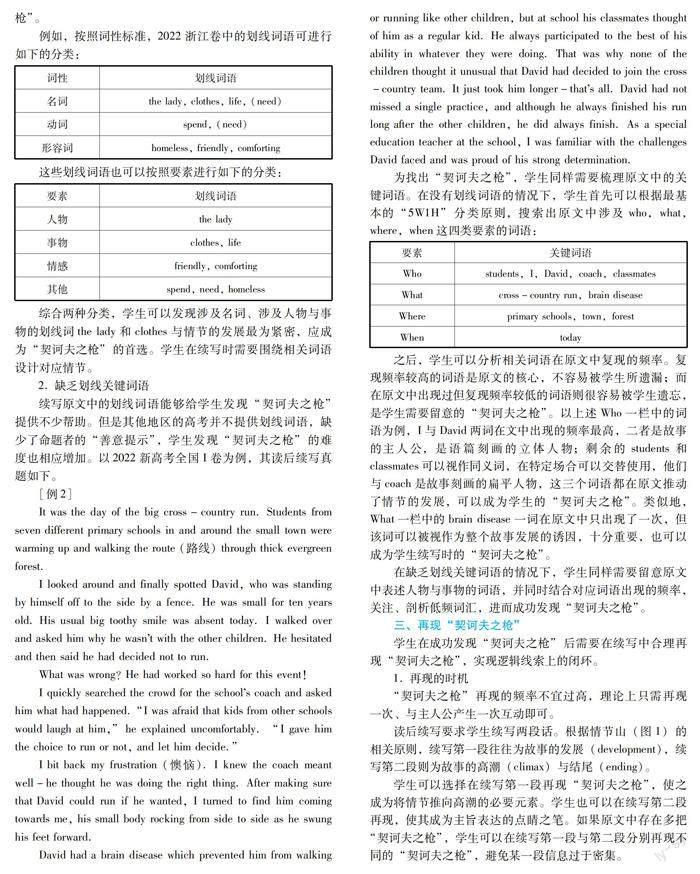利用契诃夫法则优化读后续写情节设计
2023-05-30沈奥
沈奥


一、引言
读后续写作为一种半开放性质的写作形式,要求学生依据所给语言材料、所给段落开头语进行续写,进而将其发展成一篇与给定材料有逻辑衔接、情节和结构完整的短文。情节设计是学生在进行续写时的重要环节,但由于阅读输入不足、生活经验欠缺等问题,学生在设计续写情节时的表现往往不尽如人意。对此,学生可以学习契诃夫法则的相关内容,实现对读后续写情节设计的优化。
契诃夫法则又称“契诃夫之枪”,这一名称来源于俄国大作家契诃夫曾经说过的一段话:在故事开头出现过的物品一定要在后来使用到,否则它就不应该在故事开端出现。假如一部影片的开头给墙上一把用于收藏的古董枪安排了一个特写镜头,那么到影片结束的时候,它就应该发挥作用,例如最后主人公在命悬一线之际用这把枪干掉了对手;要是这把枪从头到尾都没有发挥作用,那么它压根就不应该出现在镜头里面。
契诃夫法则提示学生捕捉原文中隐藏的关键细节,并在续写中设计合理再现,实现续写与原文在逻辑线索、情节发展等维度上的高协同。契诃夫法则也对培养学生的阅读素养起到了反拨作用。本文结合2022浙江卷与2022新高考全国I卷中的读后续写语篇,探究学生如何依据契诃夫法则优化情节设计,产出优秀的读后续写语篇。
二、发现“契诃夫之枪”
为成功使用契诃夫法则优化续写情节设计,学生首先需要辨识出续写原文中的“契诃夫之枪”。
1. 呈现划线关键词语
浙江卷中的读后续写原文包含多个标有下划线的关键词语,这些关键词语由命题者精心挑选,具有明显的指向性,是潜在的“契诃夫之枪”。以2022浙江卷为例,其读后续写真题如下。
[例1]
I needed to do something in my community (社区) in order to complete the community service hours required to graduate from high school. Some of my friends had signed up to spend time at a soup kitchen, so I did, too. It seemed like a good thing to do.
I thought that we would just be passing out dinners to those in need, but I found out we would be doing everything from preparing to serving the dinner. We began preparing the food, from mixing salad dressing to separating frozen meat. Much still needed to be done before dinner was served, but already outside the building many homeless people were gathering. It wasn't until a couple of hours later that we opened the doors and began serving dinner.
As the line of people came toward me, I got a little scared. I'd come face to face with the homeless: How should I act? How would they treat me? Would they hate me for having more than they did? While some of the people looked very friendly, some of them looked so dangerous. I didn't have too much time to worry about it. I was assigned (分配) to serve the salad with the lady next to me. She smiled at me and said if I needed help, she'd be right there, which I found quite comforting.
I had never seen so many people wanting food. They were of all ages and nationalities. Most of them wore clothes that were torn and dirty. Some looked like they had totally given up on life, while others seemed to be making the best of the situation, smiling and joking. Some were better off than others, but they all needed a good meal and a warm place to eat. It saddened me to think of how many people there were who did' t have a place to call home and the only food they got came from a soup kitchen.
續写原文所包含的划线词语为:spend,need,homeless,friendly,the lady,comforting,clothes,life。从理论上看,上述所有词语都是“契诃夫之枪”,但是限于续写篇幅及字数上限要求,学生需要梳理出其中最关键的词语,进而避免为了优化情节而使续写过于冗长。
为找出最关键的词语,学生需要结合语篇特征,按照一定的标准对这些划线词语进行分类。分类标准包括但不限于按词性分类、按要素分类、按因果关系分类、按时间分类、按空间分类等。其中,按词性分类是指按照名词、动词、形容词、副词等词性对划线词语进行分类,这种分类方式最为直观。按要素分类需要解析构成事物特征的要素,这些要素的划分可以是严谨的、符合科学规律的,例如人们在讨论长方体体积时,需要考虑长、宽、高三个要素;要素的划分也可以是约定俗成的,比如人们在叙述故事时经常会将其解构为时间、地点、人物、起因、经过、结果六个基本要素。按因果关系、时间、空间分类可以视作是在要素分类基础上的升级,这三种分类标准更为细致,与语篇情节的联系也更为紧密,能够给学生发现“契诃夫之枪”、优化情节设计提供不小的帮助。
在日常续写训练中,学生可以运用多个标准对划线词进行分类。如果某一划线词在多个分类标准下都能得到明确区分,那其必然是出题者预设的、希望学生使用的“契诃夫之枪”。
例如,按照词性标准,2022浙江卷中的划线词语可进行如下的分类:
这些划线词语也可以按照要素进行如下的分类:
综合两种分类,学生可以发现涉及名词、涉及人物与事物的划线词the lady和clothes与情节的发展最为紧密,应成为“契诃夫之枪”的首选。学生在续写时需要围绕相关词语设计对应情节。
2. 缺乏划线关键词语
续写原文中的划线词语能够给学生发现“契诃夫之枪”提供不少帮助。但是其他地区的高考并不提供划线词语,缺少了命题者的“善意提示”,学生发现“契诃夫之枪”的难度也相应增加。以2022新高考全国I卷为例,其读后续写真题如下。
[例2]
It was the day of the big cross-country run. Students from seven different primary schools in and around the small town were warming up and walking the route (路线) through thick evergreen forest.
I looked around and finally spotted David, who was standing by himself off to the side by a fence. He was small for ten years old. His usual big toothy smile was absent today. I walked over and asked him why he wasn't with the other children. He hesitated and then said he had decided not to run.
What was wrong? He had worked so hard for this event!
I quickly searched the crowd for the school's coach and asked him what had happened. “I was afraid that kids from other schools would laugh at him,”he explained uncomfortably.“I gave him the choice to run or not, and let him decide.”
I bit back my frustration (懊恼). I knew the coach meant well-he thought he was doing the right thing. After making sure that David could run if he wanted, I turned to find him coming towards me, his small body rocking from side to side as he swung his feet forward.
David had a brain disease which prevented him from walking or running like other children, but at school his classmates thought of him as a regular kid. He always participated to the best of his ability in whatever they were doing. That was why none of the children thought it unusual that David had decided to join the cross-country team. It just took him longer-that's all. David had not missed a single practice, and although he always finished his run long after the other children, he did always finish. As a special education teacher at the school, I was familiar with the challenges David faced and was proud of his strong determination.
為找出“契诃夫之枪”,学生同样需要梳理原文中的关键词语。在没有划线词语的情况下,学生首先可以根据最基本的“5W1H”分类原则,搜索出原文中涉及who,what,where,when这四类要素的词语:
之后,学生可以分析相关词语在原文中复现的频率。复现频率较高的词语是原文的核心,不容易被学生所遗漏;而在原文中出现过但复现频率较低的词语则很容易被学生遗忘,是学生需要留意的“契诃夫之枪”。以上述Who一栏中的词语为例,I与David两词在文中出现的频率最高,二者是故事的主人公,是语篇刻画的立体人物;剩余的students和classmates可以视作同义词,在特定场合可以交替使用,他们与coach是故事刻画的扁平人物,这三个词语都在原文推动了情节的发展,可以成为学生的“契诃夫之枪”。类似地,What一栏中的brain disease一词在原文中只出现了一次,但该词可以被视作为整个故事发展的诱因,十分重要,也可以成为学生续写时的“契诃夫之枪”。
在缺乏划线关键词语的情况下,学生同样需要留意原文中表述人物与事物的词语,并同时结合对应词语出现的频率,关注、剖析低频词汇,进而成功发现“契诃夫之枪”。
三、再现“契诃夫之枪”
学生在成功发现“契诃夫之枪”后需要在续写中合理再现“契诃夫之枪”,实现逻辑线索上的闭环。
1. 再现的时机
“契诃夫之枪”再现的频率不宜过高,理论上只需再现一次、与主人公产生一次互动即可。
读后续写要求学生续写两段话。根据情节山(图1)的相关原则,续写第一段往往为故事的发展(development),续写第二段则为故事的高潮(climax)与结尾(ending)。
学生可以选择在续写第一段再现“契诃夫之枪”,使之成为将情节推向高潮的必要元素。学生也可以在续写第二段再现,使其成为主旨表达的点睛之笔。如果原文中存在多把“契诃夫之枪”,学生可以在续写第一段与第二段分别再现不同的“契诃夫之枪”,避免某一段信息过于密集。
以2022新高考全国I卷为例,原文中存在coach与brain disease两把“契诃夫之枪”。根据上述原则,学生可以在续写第一段再现coach一词,描绘coach与主人公“I”和David产生的新互动,而coach在态度上的转变使David下定决心参赛,以此使coach这个扁平人物推动情节的发展。学生可以在第二段再现brain disease一词,以此烘托出主人公David不畏身体缺陷、尝试自我突破的坚强品质,点明语篇鼓励读者勇于挑战的正向价值,实现续写与原文在思想主旨维度的高协同。
2. 再现的方式
再现“契诃夫之枪”的方式也有讲究。以主人公的视角为基点,“契诃夫之枪”的再现方式可以分为“主人公主动搜索”及“主人公被动遭遇”。
所谓“主人公主动搜索”,是指主人公通过事件的推进意识到了某一人物、事物对于解决当前冲突的重要性,进而主动与“契诃夫之枪”产生交集,再次将后者拉入读者的视野。例如在2022新高考全国I卷中,上文提到的“契诃夫之枪”可以通过这一方式再现:主人公意识到是coach的话语影响了David,进而主动找到coach,二人一起与David谈心并改变David的看法,成功说服David参加比赛。又如在2022浙江卷中,the lady一词作为“契诃夫之枪”也可以通过这样的方式再现:主人公在分发食物时手忙脚乱,并回忆起the lady的话语“…and said if I needed help, she'd be right there…”进而主动寻求the lady的帮助,顺利完成志愿者活动。“主人公主动搜素”的再现方式对于学生而言相对容易掌握,但这一方式也有刻意之嫌,有时候会使故事情节发展不那么自然。所以,当自身的语用能力达到一定水平时,学生可以使用“主人公被动遭遇”的方式再现“契诃夫之枪”。
所谓“主人公被动遭遇”,是指主人公在不自觉中接触到了“契诃夫之枪”,并在其帮助下顺利解决矛盾。例如2022新高考全国I卷中的“契诃夫之枪”coach也可以通过这一方式再现:coach在无意中听到了主人公与David的谈话,并意识到自己之前的话语对David影响之大,进而主动介入二者的对话,积极鼓励David参赛。这一再现方式相较于“主人公主动搜索”更为自然。若能在续写第二段使用使用这种方式再现伏笔,更有可能产出“意料之外、情理之中”的欧亨利式结尾,让续写的情节更为出彩。
通过学习发现与再现“契诃夫之枪”的相关技巧,学生可以在2022新高考全国I卷产出如下的续写作品:
We sat down next to each other, but David wouldn't look at me. I asked him if he really decided to quit. He hesitated a lot and murmured, “I do want to have a try, but other kids will tease me…” He lowered his head and stared at the ground. At that time, the coach appeared, he said that he noticed our chat and expressed his sorrow to David. We assured David that he would be the best runner on condition that he finished the run. Hearing our words, David stood up, straightening his small body and moving through the crowds with determination.
I watched as David moved up to the starting line with other runners. The signal pistol going off, David rushed out but no wonder he was left far behind. His unusual movement drew audience's attention. With all eyes fixed on him, his small body was gradually swallowed up by the thick forest. After a long time, David emerged from the forest, making his way to the finish line with everyone's applause and cheering. Obviously, brain disease could never defeat a boy with strong determination.
该续写选择在故事的发展部分再现the coach,在结尾部分再现brain disease。解铃还须系铃人,通过在续写第一段以“主人公被动遭遇”的方式再现the coach及其开导,David能够更自然地解开心结,推动情节发展。而结尾部分对brain disease的再现,则在完成故事逻辑闭环的同时实现情感的升华。
四、结语
1. 忠实原文
根据契诃夫法则,故事作者在设计情节时会在故事的开始与发展阶段设置诸多伏笔,摆放多把“契诃夫之枪”,读后续写语篇亦是如此。这启示学生研读续写原文,通过搜索、分类等措施找出隐藏在原文中的“契诃夫之枪”;同时,结合上文发现“契诃夫之枪”的内容,续写原文中的伏笔已经十分丰富,这也提示学生在续写时不要随意增添新人物、新事物,借此来解决故事冲突;不要为解决矛盾而可以制造新的矛盾,而应忠实原文,找好、用好原文提供的线索,让续写情节和作者思路在高协同的状态下推进。
2. 关注留白
留白是中国艺术作品创作中常用的一種手法,具体指艺术创作为使整个作品画面、章法更为协调而有意留下相应的空白,留有想象的空间。学生在续写时也应该关注留白,不把故事“写满”。这是因为作者在设计整个故事情节时往往会在前文放置多把“契诃夫之枪”,这些伏笔理论上也都能够在原故事结尾得到呼应;但考虑到读后续写是经过改编后的语篇,且存在篇幅和字数的上限要求,学生就不能够在续写中再现所有的“契诃夫之枪”,而应该回应一到两个最关键的伏笔,用最精确的手段解决故事的主要矛盾,对剩下的“契诃夫之枪”则采用留白处理。
责任编辑吴昊雷
